Biology
Polar ecosystem is simple enough for non-expert eye to see its principles. Its beauty is even greater for it.
Terrestrial life begins in the sea. Great numbers of sea birds have been nesting along the coast and on the high coastal cliffs. They seek food in the sea but they live on the ground. Their guano, washed down from the cliffs by rain is a good fertilizer for modest artcic plant life. Thanks to this, it is possible to to observe from the great distances the bright patches of green in sharp contrast with surrounding yellow-brown tundra. The green plants attracxt raindeer. And if you happen upon a small patch of tall green grass in the inland, it is likely it grows from a body of a raindeer that did not survive some of the previous winters. Such patches can linger for several years, which tells us how slowly any change comes to tundra in harsh polar climate. Even decay of the dead body is much slower. Of course, the tracks after passing of the vehicle or other reminders of human presence heal this slowly, too.

Sea life
The richest life thrives in the sea and near the sea. Several seal species live in the sea. It is possible to sight a seal just about anywhere along the coast. They are curious, they had always come to cautiously check out our boats. The seals obviously need ice, a lot of them can be seen near the glacier fronts, especially when there is floating ice large enough for them to climb out of the water.Far to the north, out of the Isfjord area there are walruses.


Seals near Nordenskjoldbreen.
Also many species of cetaceans are common in surrounding sea and are often sighted in the fjords. Beluga whales are among the most famous and interesting representants of the of this group of animals. Whale bones of varied size are fairly common sight along the coast, sometimes quite far from the water. In some cases it could be the reminder of Svalbard's whaling history, in others the reason could be the shift of the coast line as the sea carries in more material.



Small whale skeleton in Sassenfjorden (left). Old fragment of large skull in Colesbukta (middle and right).

According to the finds on the coast, the samples we saw in the boat of russian divers and what the people from Czech station say, there is surprisingly abundant life on the sea bottom. There is several kinds of moluscs, their shells scattered on the beaches or even in tundra, where they likely get carried by birds. Empty crab shells can be found too, we can only guess whether the crab gave it up voluntarily as old and small of became a bird lunch. The seaurchins found along the coast usually have the telltale holes after the bird's beak. There is not much fish in the sea, fishing is not the way how to enrich the traveller's menu. On the other hand when the tide is low one can always share the small crustaceans with local birds.

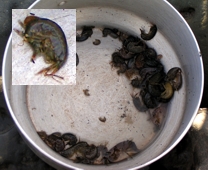
The shell of the crab (left). Small crustaceans can become a good meal (right).
Sea birds
There is many species of birds that bring life from see to barren ground. Some spend their life mostly in the air. There are seagulls occassionally flying deeper inlands, or fulmars gliding calmly with no motion of wings even in strong wind.


Arctic tern (left) Fulmar (right).
Arctic terns are agile flyers, they often hang over one spot to suddenly fall into waves after spotting a prey. Unfortunatelly they have unpleasant tendency to peck any passer-by or attack them with their droppings. It helps to carry some pole above the head.

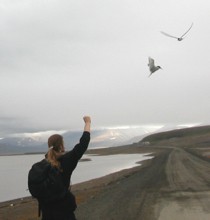
Agile terns. If you don't want to get pecked, it is usefull to hold something above your head. Anything...
Seaguls or terns may fall prey to rapacious skua that tres to take their catch in fascinating aerial fights. Skua is only seabird that can occassionally be seen deep inland.
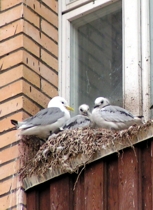

Kittiwakes nesting on the deserted buildings of Pyramiden (left) Skua (rights).
Various guillemots or puffins preffer water and are not as good in the air. In july or early August, young guillemots can be seen leaving the nests trying for their first flight from the cliffs to the sea. Some make it to the safety of water, othersend their jump in tundra under the cliff. Then they must run for the water before they get caught by some of the polar foxes always prowling nearby.
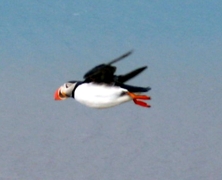

Puffin gliding inthe strong wind (left). Puffins on the water (right).
We managed to take video of gliding puffin on the cliffs in Templefjorden in a windy weather.
And of course, there are various species of ducks and eiders. The barnacle gees graze the green vegetation in wide walleys, later in summer they flock near freshwater lakes, rivers even sea shore. On the lakes near the shore we observed several couples of red-throated divers. On the edge between the land and water there are sandpipers searching constantly the seashore as well as tundra.


Barnacle gees near Brucebyen (left) Inconspicious but animated sandpiper in tundra (right).
Terrestrial animals
there is not many species of animals on the ground. Perhaps in any dale anytime you look around you can see raindeer. The small herds are spread wide as each animal strives to graze as much of the poor vegetation as possible.


Lazy raindeer in Longyearbyen (left) Raindeer grazing on the coasts of Bellsund (right).
Another mammal living on the islands is polar fox. They can often be seen on the shoreline searching for anything washed up by sea or they rob the nests of terns and other seabirds nesting on flat ground. The fox is usually cautious and quickly gets even out of camera's reach. If you meet the same fox regularly, they may become quite tame.


Fox roaming the vicinity of Russanov cabin (left) Prowling near the coastal shallows bring the fox the unpleasant attention of terns (right).

There are two species of terrestrial birds in tundra. Ptarmigans and snow buntings. Ptarmigan is excelently camouflaged bird that can be met just about anywhere on the islands, most likely where it can feed on the plant seeds. Snow bunting, the small passerine, lives on limilar diet. Insects are rare (some spiders and small amount of mosquitos), so the insect hunting species are not present at all.


Ptarmigan (left) Flock of ptarmigans caught in the green, where they arebetter visible (right).
It is neccessary to mention the most important of natural inhabitants of Svalbard, the polar bear, or perhaps the sea bear, as its latine name is ursus maritimus. There is some 3000 bears on Svalbard and they are strictly protected. They eat seal (the fat of seal, more precisely), which they hunt on frozen sea. During summer they roam the land and they starve. Although the visitor of Svalbard is attacked by "fear the bears" propaganda on each step in Longyearbyen, we have heard, thet only 2% bear encounters end by an aggression from the bear. But because of these 2% it is worth to be prepared, rifle is recommended (.308 Winchester or stronger), firecrackers, tripwire and flares as well.


Vegetation
Plant communities on Svalbard are surprisingly rich in number of species as well as in number of communities. In many places the vegetation has a mosaic character, over a small area it can alternate between the ridge vegetation and that typical for wetland. The plant life depends on many factors among others on the thickness of the snow-cover, that is given by the shape of the terrain where the wind moves the snow.



Cassiope tetragona (left) a Mountain Aven.
There is a division of Svalbard into the vegetation zones based on the dominant plant species. These are the four zones: Cassiope tetragona, Dryas octopetala, Salix polaris and Papaver dahlianum which grows even in otherwise barren places.


Polar willow (left; for the picture we thank to Oleg Ditrich from Unoversity of South Bohemia) and Arctic poppy Papaver dahlianum (right).
Another subdivision is based on adaptation of the plants to particular habitats and ecological conditions. Thus we can make a very simplified grouping of plant communities: Ridge vegetation, Snow-bed vegetation, Heath vegetation, Wetland vegetation, Shore-meadow vegetation and Fertilized vegetation. There can be more of these habitats and communities even over a small area.
Mosses and lichens are a significant component of all these communities. In the mountains and mainly in the snow-bed areas where the soil is poor but saturated with thaw water,there can be a majority of them.


Snow-bed vegetation: mosses and lichens (left) one of the buttercups (right).
The ridges and slopes open to the wind have only a thin snowcover, the snow melts early in the spring but leaves not much moisture. This is the habitat for Mountain Aven, White Arctic Bell-heather, sometimes the willow and number of herbs, saxifrages, buttercups, louseworts. Horské svahy bývají větrem zbavovány silné sněhové pokývky, proto z nich sníh mizí na jaře nejdříve, ale zase nemívají mnoho vláhy. Zde roste hlavně dryádka, vřes, místy i vrba, a také množství různých bylin, všivce, pryskyřníky, lomikameny.

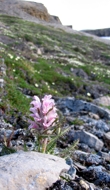

Moss Campion (left), Wooly Lousewort (middle) and Polar Stoloniferous Saxifrage (right).
Heath vegetation grows on plains with a moderate snow-cover, where the amount of moisture changes during summer. It is rich in number of species and it is a common grazing ground for raindeer. This type of vegetation covers most of the large valleys in the Isfjord area. Besides the grass species, there is more saxifrages, arctic dandelions, daisies and unmistakable pathes of Moss Campion. Also there can be found the rare dwarf birch, the only "tree" besides the willows.

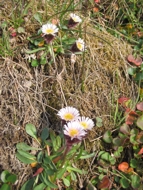
Mushrooms in the dwarf birch patch (left) and daisies among the leaves of Mountain Sorrel (right).
Moss tundra and arctic mires on the flat valley bottoms it is a home of wetland communities. Many grasses, mosses and also the herbs grows here. The cotton grass is characteristic for the valley bottoms. Surprisingly there is a species of saxifrage in the mires as well.



Yellow March Saxifrage (left) and cotton grass.
Shore-meadows are the areas in the river deltas where the sea water can reach during the high tide. Salt water and nutrients from the sea is also present in the communities along the beaches.


Beach vegetation samples.
The green slopes under the bird cliffs whrere many plants grow of well fertilized soil are a cathegory of itself. Although these slopes can be quite steep, they are a grazing ground for raindeer.

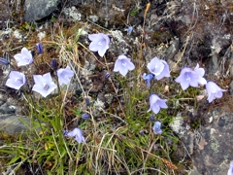
There is many a plant species on Svalbard. Lots of beautifull flowers can be seen there, strangely, for without a significant numbers of insects the plants use only the wind to fertilize and they have no need for colorfull flowers. Although the barren landscape makes the flowers only more beautifull, we from Central Europe always eventually start to miss trees...
